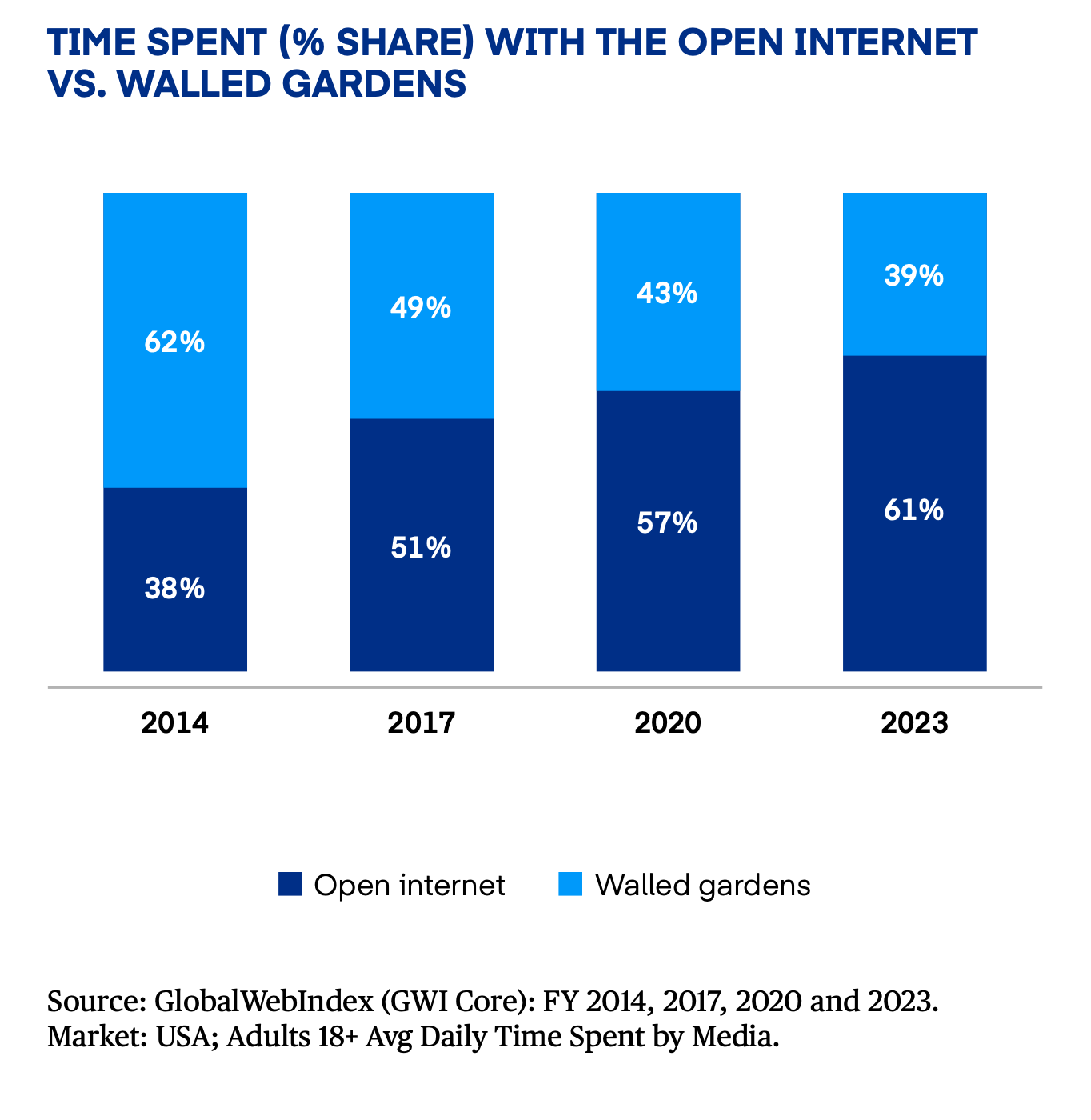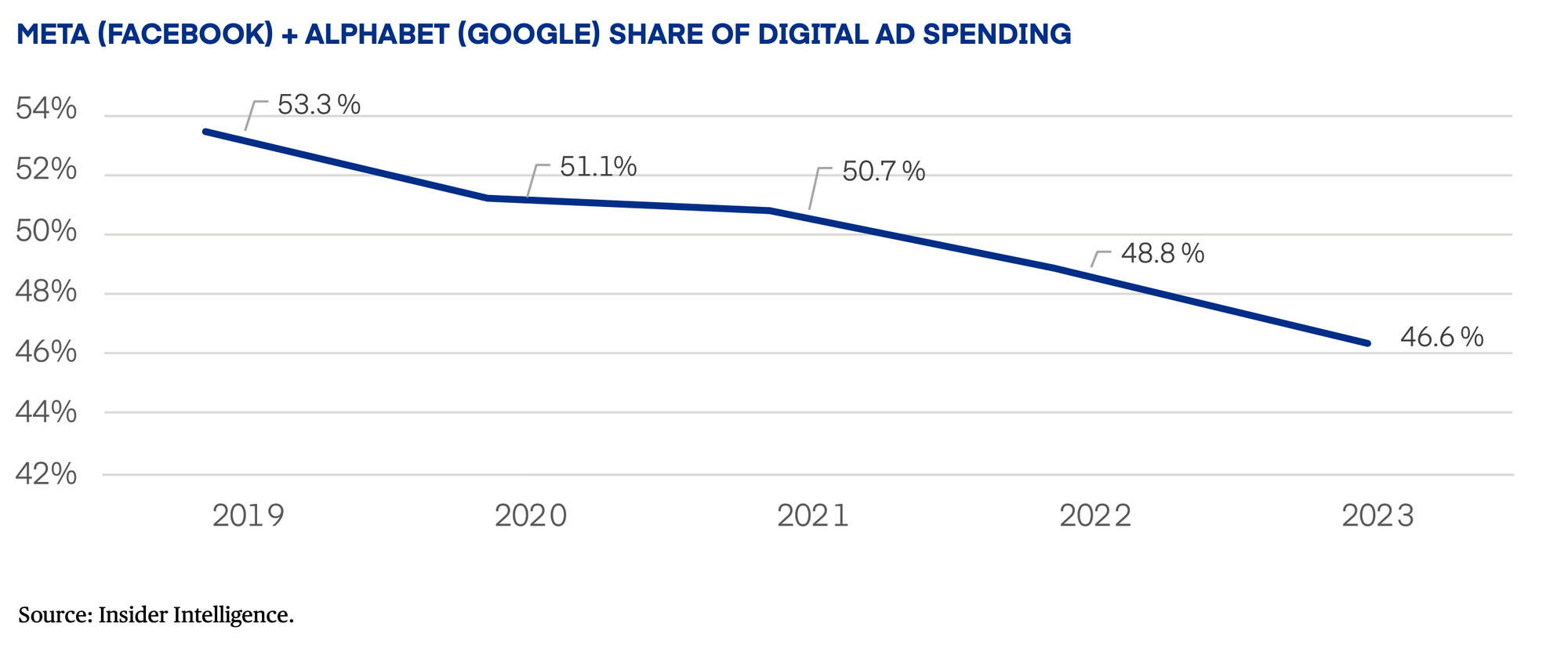During The Trade Desk's Q1 earnings call, CEO Jeff Green slipped in the phrase "premium Internet" five times. Nobody from The Trade Desk mentioned the premium Internet once during its previous Q4 2023 earnings call.
A few weeks later, the company released its Seller's and Publisher's Report with an accompanying subtitle of "The Rise of The Premium Internet." From the report:
This report examines why and how advertisers are gravitating to the best of the open internet — the premium internet. It highlights the impact of exciting new channels such as CTV and digital audio, and how a new open internet identity fabric is revaluing the internet right now. Even though consumers spend the bulk of their time on the open internet, walled gardens, collectively, still account for the bulk of digital advertising spending.
The Trade Desk is pivoting from positioning itself as the DSP of the open Internet to the go-to DSP for the premium Internet. But why are they doing this?
Premium Internet vs Walled Gardens
The Trade Desk wants advertisers to stop thinking about an "open Internet" full of rinky-dink display banners, made-for-advertising garbage, and non-transparent inventory.
Instead, The Trade Desk desires to reframe inventory available via its platforms as a viable alternative to the walled gardens comprised of high-quality and authenticated premium CTV video and digital audio placements.
The Trade Desk already dominates as a DSP. Jeff Green pointed out on their earnings call that "more than 90% of the Ad Age Top 200, the largest 200 advertisers in the world, have run advertising campaigns on our platform over the last 12 months."
If the company already has the majority of top advertisers as its clients, how does it continue to grow?
The Trade Desk needs to set its sights beyond meager competition from other DSPs and independent ad platforms to continue its growth story and satisfy investors. The company wants advertisers to believe its available inventory is preferable to that of the walled gardens to, as Mr. Green says, "gain more than our fair share of the nearly $1 trillion advertising TAM."
Green continues to paint this tale of two inventory pools:
For the last couple of years now, we've delivered consistent, durable revenue growth over 20%, significantly outpacing the broader market, including the major walled gardens. And it's because of the contrast between the best of the open Internet, what you might call the premium Internet and the content and characteristics of walled gardens, has never been more apparent...there is a broader understanding of the role that walled gardens are playing as major purveyors of low-grade, made-for-advertising inventory. Second, there is a much wider understanding of how bad ad-to-content ratios within walled gardens and the brand suitability risk of user-generated content or UGC. This is in part due to the stark contrast that premium content has right now to UGC.
Take that walled gardens (aka Google and Meta)! We are growing faster, you created the problem of MFA inventory by generating cheap referral traffic, and you surround your crappy user-generated content with too many ads.
Meanwhile, The Trade Desk contends that they represent more refined artisanally crafted premium content:
It's premium quality content that captivate consumers who spend significant amounts of time engaging with it. No one watches Mandalorian or Curb Your Enthusiasm or March Madness casually. No one listens to their favorite podcast passively. I found in every aspect of my life, I can't talk to anyone about premium CTV content or the best of music without people sharing a passion for some form of those mediums. We are all highly invested in it. That's very different than how consumers engage or talk about social media content, which is often short-form UGC video, such as cat videos or 14-year-olds filming themselves falling off from bicycles. However, people spend much more time with premium content such as streaming TV and digital audio than they do with UGC. Our research shows consumers spend about 60% of their online time on the open Internet.
So there you have it, folks. Do you want your brand sandwiched between cat videos or associated with big-budget masterpieces like the Mandalorian? A compelling but oversimplified bit of marketing by Jeff and his crew.
The Trade Desk wants advertisers to think it is the best place to conduct their brand's storytelling adjacent to high-quality content, but TTD is telling its own story here. The company wants to create a quality-over-quantity argument to compete with Meta and Google's virtually infinite supply of logged-in users.
TTD would also like you to know that the walled gardens' dominance of user time spent is declining year after year:

And that Google and Meta's duopoly grip on digital ad spending is also on a downward trend:

Absent from this chart is any mention of the Amazonian-sized elephant in the room — Amazon accounted for 10.2% of digital ad spending in 2023 and certainly ate into Meta and Google's share during this period. But attacking a walled garden that also happens to be a retail media juggernaut does not play very well when you are powering the next best retail media solution, Walmart Connect's DSP.
So TTD is stuck roasting Meta and Google. Sure, they may have unlimited scale and precise user-level targeting available with every opportunity — but TTD wants advertisers to remember it’s all cat videos.
If users allegedly spend more time away from these destinations and more time on inventory The Trade Desk can access, why do they still account for 46.6% of total digital ad spending?
If The Trade Desk can hammer thousands of supply sources into their ideal shape of a premium Internet, they believe they can chip away at the duopoly's ad spend share and spread the spoils far and wide to all publishers.
The Trade Desk's Internet
The Trade Desk's premium Internet is more than a branding exercise; it's a call to publishers to get their act together for the next stage of the ad-supported Internet's lifecycle.
For The Trade Desk to realize its vision of a premium Internet that can go head to head with the walled gardens, it needs publishers to adopt its strategies to maintain user identity (UID2) and a pristine supply path (integrate OpenPath).
How do you make publishers bend to your vision of the Internet? You pit them against each other, and that's precisely what The Trade Desk did by publishing a list of who it considers to be the best publishers:

The Trade Desk crafted this list of web, CTV, and digital audio publishers in partnership with Sincera by assessing each property "according to a range of criteria, including advertising quality (such as viewability, ads to content ratio and refresh rate), reach, decisioned programmatic inventory, supply path efficiency, and distribution quality."
Now, each publisher may be stuck wondering why they fell to the spot they're in and will be hitting up TTD to figure out how to ratchet up the rankings — playing right into TTD's OpenPath strategy to form closer ties with publishers.
It's also curious that Disney takes the top two spots, given that the company recently announced an OpenPath integration directly into the Disney Real-time Ad Exchange, which includes Hulu and Disney+. This integration is in addition to Disney already supporting The Trade Desk's UID2. Disney is doing everything a good little publisher should do to win in The Trade Desk's premium Internet.
However, Disney also checks the reach and distribution quality boxes more than many publishers on this list can ever hope to attain. That leaves most publishers only improving their ranking in the near time by focusing on things they can immediately control, like viewability, ads-to-content ratio, and refresh rate.
TTD API docs also mention content signal transparency as a factor, so this may be the push TTD needs to have some holdout publishers pass valuable content metadata like genre, rating, production quality, etc.
Productizing the Premium Internet
While this list may have publishers capitulating to The Trade Desk's desires to jump the rankings, what can advertisers do with it? That's where the Sellers and Publishers 500+ comes in.
The Sellers and Publishers 500+ is a list of publishers actively managed by The Trade Desk using most of the same criteria from the top 100 list above. Instead of crafting deals and inclusion/exclusion lists, advertisers can filter for only SP500+ properties and outsource the laborious task of maintaining inventory quality on the open web to The Trade Desk.
SP500+ includes thousands of publishers despite its name, as evidenced by the disclosure at around 1:45 in the video above. I suspect TTD went with 500+ because it has existing brand recognition (sorry, Standard & Poors), and SP20,000+ doesn't quite roll off the tongue nor evoke a sense of a tightly controlled inclusion list.
To summarize, what is The Trade Desk's Premium Internet?
- A rebranding exercise of the Internet to entice advertiser budgets away from the closed walled gardens of Google and Meta
- A call to action for publishers to clean up their acts to maximize their potential demand from The Trade Desk
- A new paradigm of targeting quality inventory across the open web within The Trade Desk's platform
- A storytelling tactic to weave a compelling narrative for investors to align with The Trade Desk's vision of maintaining growth
The simple phrase "premium Internet" concisely encapsulates The Trade Desk's multifaceted strategy across marketing, product, and publisher relations.
The Trade Desk wants to rally all publishers to collectively challenge Meta and Google and cement its place as the gateway to buying everything outside the walled gardens. Now, we will see if publishers answer the call and if the mission resonates with advertisers and investors.


